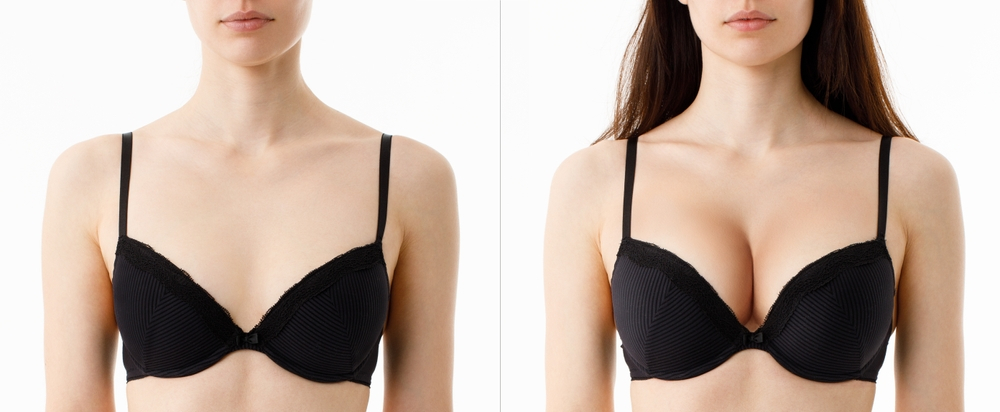Breast implants often provide satisfaction for years but may eventually need replacement due to various factors such as lifestyle changes or implant aging. Being aware of the signs and reasons for replacement can help you make a timely decision and retain your results.
At eSSe Plastic Surgery in Fort Lauderdale, FL, we offer breast implant replacement for when this time comes. We address the diverse reasons patients may seek this service, from personal desires to medical necessities. Our approach is to offer comprehensive solutions that meet the evolving needs of our patients so they can continue to be happy with their breast augmentation.
What Is Breast Implant Replacement?
Breast implant replacement is a procedure undertaken when a previous breast augmentation needs updating or correcting. This could be due to a range of medical and aesthetic factors. The process involves removing the old implants and replacing them with new ones, which may also involve adjusting the surrounding tissue for optimal results.
Reasons for Breast Implant Replacement
- Improved Breast Symmetry and Shape: Opting for breast enhancement can correct disparities in size or form, leading to more balanced and aesthetically pleasing contours.
- Resolution of Issues: Breast implant revision is often pursued to address complications such as capsular contracture. Undergoing capsular contracture treatment can alleviate discomfort and restore the natural feel and look of breasts.
- Opportunity to Update Breast Implant Size or Type: Changing preferences or lifestyles can lead to a decision for breast implant removal and replacement. This allows for altering the size or type of implants to better suit current desires or body changes.
- Enhanced Comfort: Advances in breast enhancement techniques and materials can significantly improve physical comfort and reduce the sensation of heaviness, leading to a more natural and relaxed body feel.
- Access to Latest Implant Technologies: Breast implant replacement gives the opportunity to upgrade to the latest implant technologies. Newer materials and designs offer improved safety and aesthetic outcomes, aligning with the latest standards and expectations.
Types of Breast Implant Replacement Options
Same Size, New Implants
Implants naturally wear out over time and can cause rippling, deflation, or shell weakening. Replacing them with the same size maintains the current look while upgrading to newer implants with better durability and feel. Even without size changes, modern implants can improve overall appearance and comfort.
Size Adjustments
Implant replacement offers the chance to increase or decrease size based on aesthetic goals or lifestyle changes. Larger implants may require pocket expansion, while smaller implants might need pocket adjustments or a breast lift to prevent sagging. Skin elasticity and chest proportions help determine the best fit.
Switching Implant Types
Patients may decide to switch from saline to silicone for a softer feel or choose saline implants for easier leak detection. Smooth implants allow natural movement, while textured implants help reduce shifting. If capsular contracture is a concern, changing implant type or placement can improve comfort.
Combining With a Breast Lift
A breast lift can enhance implant replacement results by addressing sagging, repositioning the nipple, and improving firmness. Small lifts may only require an incision around the areola, while larger lifts reshape the breast using larger incisions vertically across the breast.
Correcting Implant Position
Implants may shift over time due to capsular contracture, gravity, or tissue changes. This type of revision surgery adjusts the pocket to restore balance. Changing implant placement either above or below the muscle can provide better long-term support, depending on your situation.
Breast Implant Replacement vs. Breast Implant Removal
Pros of Replacement
Replacing breast implants maintains volume and shape while addressing concerns like rippling, deflation, or shifting. Patients can switch to modern implants with improved durability, feel, and projection. Those looking for subtle changes may opt for a different size, shape, or material to better match their aesthetic goals. Replacement can restore firmness and prevent sagging while maintaining the volume that you want.
Pros of Removal
Removing implants eliminates the need for future maintenance or potential revision surgeries. Patients experiencing capsular contracture, discomfort, or lifestyle changes may prefer to return to their natural breast shape. Some opt for removal to avoid concerns about implant longevity or complications. A breast lift may be recommended to reshape the breast and prevent a hollow or sagging appearance, particularly if larger implants are removed.
Choosing the Right Type of Implants for Replacement
Saline vs. Silicone
Saline implants contain a sterile saltwater solution and offer a firmer feel. They are filled after insertion, allowing for smaller incisions and minor adjustments in size. If a leak occurs, the harmless saline solution is absorbed by the body, and ruptures are easier to detect. Silicone implants provide a softer, more natural feel and are less prone to rippling. They require a slightly larger incision and need to be monitored for rupture. Both options have advantages, and the choice depends on personal preference, body type, and the desired look.
Gummy Bear Implants
Gummy bear implants are cohesive silicone gel implants that maintain their shape even if the outer shell is compromised. Their thicker consistency makes them more resistant to rippling and shifting while providing a firmer feel than traditional silicone implants. They are often shaped to mimic the natural slope of the breast and have a textured surface to keep them in place. Since they are denser, they may require a slightly larger incision for placement.
Round vs. Teardrop-Shaped Implants
Round implants provide fullness at the top of the breast and create a more lifted and voluminous look. Because they are symmetrical, they do not shift noticeably if they rotate within the breast pocket. Teardrop-shaped implants have a gentle slope that mimics the natural breast contour with more volume at the bottom. They are often preferred for a subtle, natural enhancement, but since they are not symmetrical, they must stay in position to maintain the intended shape.
Smooth vs. Textured Implants
Smooth implants allow for more natural movement since they can shift slightly within the breast pocket. They tend to feel softer than textured implants but may be more prone to movement over time. Textured implants have a rough surface designed to adhere to surrounding tissue, which reduces implant shifting. This can be beneficial for teardrop-shaped implants, as it helps maintain their orientation.
Signs That It May Be Time to Replace Your Implants
- Rupture or Deflation: If you have saline implants and you notice a sudden loss of breast volume, it is time to schedule an appointment with your surgeon. If a rupture is detected in your silicone implant during a routine MRI, this is another indication that a replacement is needed.
- Capsular Contracture: If the area around your implant tightens and begins to feel uncomfortable, hard, or unnatural, you may have capsular contracture. Implant replacement and other surgical measures may be necessary to resolve the issue.
- Rippling or Wrinkling: Rippling is more common with saline implants or when there is minimal natural breast tissue covering the implant. It may be seen along the edges of the breast or felt under the skin. Choosing a different implant type or adjusting placement can help address the issue.
- Noticeable Shifting, Displacement, or Asymmetry: Shifting may cause an uneven look, with one implant sitting higher, lower, or farther apart than the other. If symmetry has changed significantly, a replacement can restore balance.
What to Expect From the Breast Implant Replacement
Step 1: Anesthesia
The initial step in the breast implant procedure involves administering anesthesia, which is essential for providing a pain-free experience. The type of anesthesia used, whether local with sedation or general, will be determined based on the patient’s health, preferences, and the complexity of the procedure.
Step 2: Removal of the Old Implant
This stage involves the careful extraction of the existing breast implant. The breast implant removal is conducted with precision to preserve the integrity of the breast tissue and minimize tissue damage. The process involves making incisions and then meticulously extracting the old implants.
Step 3: Capsule Modification If Necessary
In cases of capsular contracture or when adjustments to the breast pocket are required, this part of breast implant surgery involves modifying or removing the surrounding scar tissue. This step in your breast implant revision is essential for creating a suitable environment for the new implant and making sure it sits correctly within the breast for a natural look and feel post-surgery.
Step 4: Insertion of the New Implant
Following the removal and any necessary modifications, the breast implant replacement process continues with the insertion of new implants. This involves placing and aligning the new implants within the breast pockets, with the surgeon’s expertise guiding the symmetry, proper placement, and fulfillment of the patient’s expectations.
Step 5: Closure of Incisions
Once the new implants are securely positioned, we will close the incisions with sutures. The aim is to do as clean and meticulous a job as possible to minimize visible scarring after your procedure. Then, the area is wrapped in bandages to keep everything in place.
Step 6: Recovery and Follow-Up
The final step involves the patient’s recovery and the subsequent follow-up appointments. After the breast implant procedure, patients are given specific instructions for care, including how to manage pain, care for the incision sites, and when to resume normal activities. Regular follow-up visits are important for monitoring the healing process, assessing the outcome of the surgery, and addressing any concerns.
FAQs About Breast Implant Replacement
How Long Does Breast Implant Replacement Surgery Take?
The duration of a breast implant replacement procedure can vary based on individual circumstances, including the complexity of the surgery and whether any additional adjustments are needed. Typically, the surgery takes between one and three hours, but this may be different for you. We will inform you of the expected timeframe during your pre-surgical consultation so you can plan accordingly.
What Is the Recovery Time After Breast Implant Replacement?
Recovery from breast implant surgery varies with each individual, influenced by their overall health and the specifics of their surgery. Generally, most patients can resume light activities within a week, but complete breast implant recovery usually takes several weeks. Detailed post-operative instructions will be provided to give you a smoother healing process.
Will I Have Additional Scarring After Breast Implant Replacement?
Scarring is a natural outcome of any surgical procedure, including breast implant replacement. However, surgeons typically make incisions in discreet locations, often using existing scar lines to minimize visibility. The extent of scarring can depend on individual healing processes, adherence to post-operative care instructions, where you had your incisions during the first augmentation, and where we recommend the incisions be for this procedure.
How Much Does Breast Implant Replacement Cost?
The cost of implant replacement surgery varies depending on the type of implants, the complexity of the procedure, and whether additional adjustments, like a breast lift, are needed. Surgical fees typically include anesthesia, facility costs, and the surgeon’s expertise. If replacement is necessary due to capsular contracture, rupture, or shifting, the cost may be higher depending on the extent of the correction. During a consultation, we can provide a clearer estimate based on your situation.
How Often Do Breast Implants Need to Be Replaced?
There isn’t a set expiration date for breast implants. Some last for ten years or more without issues, while others may need replacement sooner due to rupture, capsular contracture, or changes in breast shape. Regular check-ups and imaging, like MRI or ultrasound for silicone implants, help monitor their condition. If there are no concerns, there’s no need to replace them just because a certain amount of time has passed.
Will My Breasts Look Natural After Replacement Surgery?
Yes, breast implant replacement can still produce natural-looking results. Replacing breast implants can refresh or refine your look, especially when the right size, shape, and placement are selected. If there’s been skin laxity over time, combining replacement with a breast lift can help maintain a youthful contour. Modern implant options, like gummy bear implants, hold their shape better and feel more natural, helping to create a smooth, proportionate result.
Am I a Good Candidate for Breast Implant Replacement?
If your implants no longer match your aesthetic goals, feel uncomfortable, or have shifted over time, you may be a good candidate for replacement breast implants. We can help you explore your options to ensure you get the results you want.
Improve Your Contour and Comfort With Breast Implant Replacement in Fort Lauderdale, FL
Breast implant replacement is a step that women take for different reasons. Whether your aesthetics have changed, you are experiencing complications, or you are ready to upgrade to a newer implant, we are here to help. At eSSe Plastic Surgery in Fort Lauderdale, FL, we provide comprehensive care and support throughout the replacement process, making sure your needs and expectations are met. For more details or to discuss your options, please reach out through our online form or call us at (954) 800-2163 for more information.




